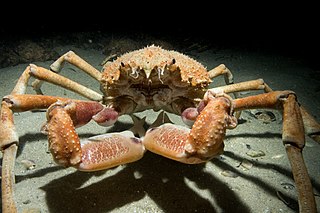
Hairspray is an American musical with music by Marc Shaiman and lyrics by Marc Shaiman and Scott Wittman, with a book by Mark O'Donnell and Thomas Meehan, based on John Waters's 1988 film of the same name. The songs include 1960s-style dance music and "downtown" rhythm and blues. Set in 1962 Baltimore, Maryland, the production follows teenage Tracy Turnblad's dream to dance on The Corny Collins Show, a local TV dance program based on the real-life Buddy Deane Show. When Tracy wins a role on the show, she becomes a celebrity overnight, leading to social change as Tracy campaigns for the show's integration.

The leafy seadragon or Glauert's seadragon, is a marine fish. It is the only member of the genus Phycodurus in the family Syngnathidae, which includes seadragons, pipefish, and seahorses.

Hormosira is a genus of seaweed in the family Hormosiraceae. It is monotypic, with a single species, Hormosira banksii, also known as Neptune's necklace, Neptune's pearls, sea grapes, or bubbleweed it is native to Australia and New Zealand.

Xanthidae is a family of crabs known as gorilla crabs, mud crabs, pebble crabs or rubble crabs. Xanthid crabs are often brightly coloured and are highly poisonous, containing toxins which are not destroyed by cooking and for which no antidote is known. The toxins are similar to the tetrodotoxin and saxitoxin produced by puffer fish, and may be produced by bacteria in the genus Vibrio living in symbiosis with the crabs, mostly V. alginolyticus and V. parahaemolyticus.

Carcinus maenas is a common littoral crab. It is known by different names around the world. In the British Isles, it is generally referred to as the shore crab, or green shore crab. In North America and South Africa, it bears the name European green crab.

Scylla paramamosain is a mud crab commonly consumed in Southeast Asia.

Portunidae is a family of crabs which contains the swimming crabs. Its members include many well-known shoreline crabs, such as the blue crab and velvet crab. Two genera in the family are contrastingly named Scylla and Charybdis; the former contains the economically important species black crab and Scylla paramamosain.

Seafood boil in the United States is the generic term for any number of types of social events in which shellfish, whether saltwater or freshwater, is the central element. Regional variations dictate the kinds of seafood, the accompaniments and side dishes, and the preparation techniques. In some cases, a boil may be sponsored by a community organization as a fund-raiser or a mixer. In this way, seafood boils are like a fish fry, barbecue, or church potluck supper. Boils are also held by individuals for their friends and family for a weekend get-together and on the holidays of Memorial Day and Independence Day. While boils and bakes are traditionally associated with coastal regions of the United States, there are exceptions.

Majidae is a family of crabs, comprising around 200 marine species inside 52 genera, with a carapace that is longer than it is broad, and which forms a point at the front. The legs can be very long in some species, leading to the name "spider crab". The exoskeleton is covered with bristles to which the crab attaches algae and other items to act as camouflage.

The Majoidea are a superfamily of crabs which includes the various spider crabs.

Notomithrax ursus, known as the hairy seaweed crab, is a spider crab of the family Majidae.

Decorator crabs are crabs of several different species, belonging to the superfamily Majoidea, that use materials from their environment to hide from, or ward off, predators. They decorate themselves by sticking mostly sedentary animals and plants to their bodies as camouflage, or if the attached organisms are noxious, to ward off predators through aposematism.

Pagurus hirsutiusculus is a species of hermit crab, commonly called the hairy hermit crab. It lives from the Bering Strait south to California and Japan, from the intertidal zone to a depth of 110 m (360 ft).

Pachygrapsus crassipes, the striped shore crab or lined shore crab, is a small crab found on both rocky and hard-mud soft seashores of the northeastern and northwestern Pacific Ocean. In North America, this species occurs from central Oregon, south through California to near Ensenada, Baja California, Mexico. There is an isolated population with a wide range disjunction at Bamfield on Vancouver Island, Canada. The western Pacific population, including both Korea and Japan is isolated with a divergence time from the eastern Pacific population estimated between 0.8 and 1.2 Mya.

The Lost Continent is a 1968 adventure film made by Hammer Films and Seven Arts featuring Eric Porter, Hildegard Knef, Suzanna Leigh, Tony Beckley, and James Cossins. The film was produced, directed and written by Michael Carreras based on Dennis Wheatley's novel Uncharted Seas (1938).
Calvactaea tumida is a species of crabs in the family Xanthidae, the only species in the genus Calvactaea.

South Korea is a major center of aquaculture production, and the world's third largest producer of farmed algae as of 2020.
Naxia is a genus of crabs in the family Majidae, containing the following species:

Self-decoration camouflage is a method of camouflage in which animals or soldiers select materials, sometimes living, from the environment and attach these to themselves for concealment.

Leptomithrax gaimardii is a species of crab in the Majidae family, first described by Henri Milne-Edwards in 1834 as Paramithrax gaimardii, from a specimen found in New Zealand waters by Joseph Paul Gaimard who is honoured by the species epithet.

















